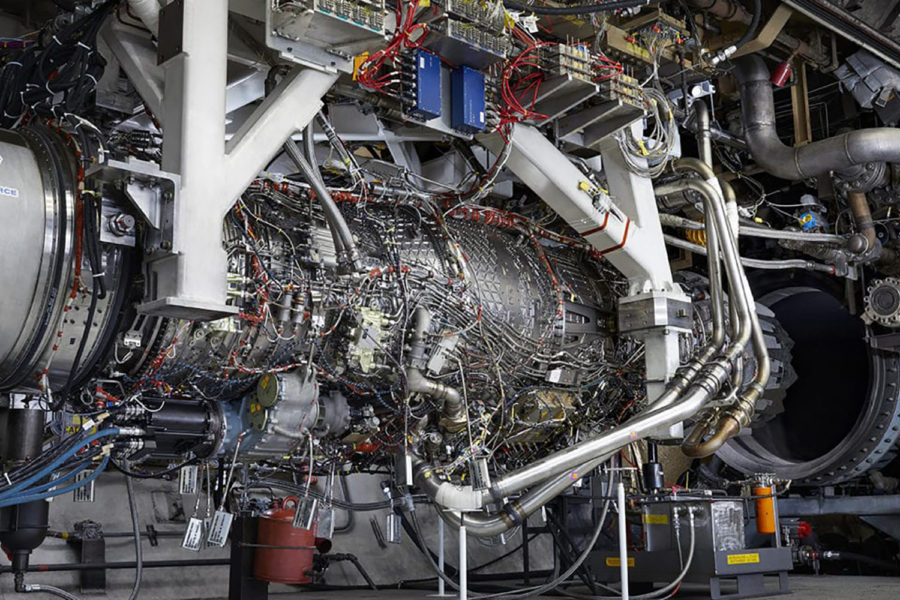A brief history of aircraft propulsion, from piston engines to early jets, to turbofans, and now GE’s advanced entry.
The first airplanes were powered by piston engines turning propellers, and when gas turbine engines emerged decades later, they quickly proved able to propel aircraft higher, further, and faster. The cycle repeated itself with the turbofan in the 1960s and ’70s.
Yet as dazzling as any new technology is when first developed, something better eventually surpasses it. Such is the case with GE’s Adaptive Cycle Engine, a new propulsion technology that can deliver either power or efficiency on demand.
The adaptive engine design entails a three-stream architecture that comes together to improve thrust by 10 percent and fuel efficiency by 25 percent. Efficient thermal management capability—the ability to dissipate heat more effectively—also enhances combat effectiveness.
Use of advanced component technologies—such as ceramic matrix components (CMC), polymer matrix composites (PMC) and additive manufacturing allows for the use of fewer parts. The results include lower sustainment costs for the F-35. The plane would have longer range and loiter times without the need for midair refueling, as well as increased speed and the ability to carry heavier ordnance payloads.
“Cold War-era engines were designed to confront the Soviets on the Eastern Front in Europe,” notes David Tweedie, General Manager for Advanced Products at GE Edison Works. “The design focus was on squeezing out the most thrust for every pound of airflow.”
Performance was valued over efficiency, because range was not a primary issue of concern.
Following Operation Desert Storm to expel Iraq from Kuwait in1991, however, planners began to see range as increasingly important. Navy aircraft flying from aircraft carriers in the Arabian Gulf lacked the range to strike deep into Iraqi territory. Air Force fighters flying from Saudi Arabia, Qatar, and Jordan needed to refuel as soon as they were at altitude. Yet the combination of stealth and precision munitions enabled the United States and its coalition partners to reduce Iraq’s army—then the world’s fourth largest—to shambles within weeks, setting the stage for a brief and overwhelming ground assault that followed.
The world was watching.
“U.S. adversaries were paying attention,” Tweedie said. They saw the value of stealth and performance, but also sought ways to counter those strategic U.S. advantages. “But one way to defeat stealth and precision is to force your adversary to keep its carriers and tankers so far away that tactical fighters can’t get to the theater of operations, can’t get close enough to conduct their mission,” Tweedie said. “That’s how our adversaries sought to negate our advantage.”
In partnership with the US Air Force, GE’s XA100, however, rewrites the book on aviation power. Turbofan technology can be optimized to do one of two things. Elongating the turbofan increases thrust, while broadening the engine’s aperture improves efficiency. The XA100 is able to reconfigure itself on demand, shifting from fuel efficiency for extended range and loiter times to high-thrust for air combat.
For GE, it’s one more step in a natural progression. “GE’s launch into the aviation business matured and developed in the 1920s and ’30s so that by the time World War II came around, many piston engines were using GE turbochargers to help with performance,” Tweedie said.
By then, both Germany and England began developing gas-turbine propulsion technology, but the British, focused with preparation for war, handed off their prototype to the U.S. GE tested its first turbojet in 1942 and its jet engines powered the F-86 Sabre during the Korean War and F-4 Phantoms and F-5 Tigers in the Vietnam War era.
Engine development is cyclical, Tweedie says. “You apply research and development money into a technology for many years before you can harness it. Then you hit an inflection point, when you really start to understand the technology, and you can deliver massive improvements in the capability of your products,” he explains. “Eventually, though, you come to a point where the technology becomes mature and you need to do something fundamentally different.”
When that happened in the 1960s, U.S. researchers developed the turbofan technology that powers most of today’s leading aircraft. Now, half a century later, the United States propulsion industry is on the verge of another breakthrough.
“We think that the same kind of generational leap is what we’re offering here with the XA100,” Tweedie says.


